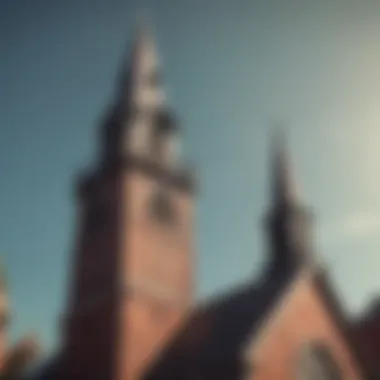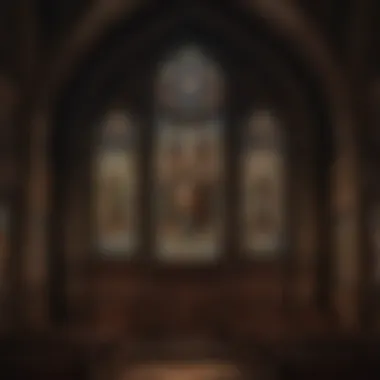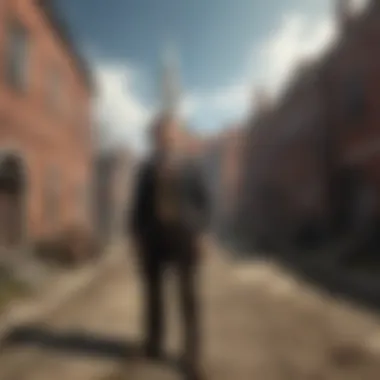The Old North Church: A Historic Beacon of Freedom


Intro
The Old North Church, standing in the heart of Boston, is more than just an architectural marvel; it is a symbol entwined with American history. Its steeple rises above the surrounding buildings, holding stories of the past—of revolution, resilience, and religious significance. Located in the North End of Boston, this church has seen the evolution of the city and the nation. Understanding its historical significance offers insight into early American life and the ideals that shaped a nation’s foundation.
This article will explore the rich tapestry of events associated with the Old North Church, the architectural features that characterize its design, and the influential figures that walked its aisles. From listening to the whispers of patriots to witnessing pivotal moments in the American Revolutionary War, the Old North Church encapsulates the spirit of a transformative era in a young nation’s tale.
Architectural Significance
The Old North Church, officially known as Christ Church in the City of Boston, holds distinct architectural features that speak to its era. With its Georgian style established in 1723, the brick structure is equipped with elegant arches and tall windows, allowing natural light to illuminate its spacious interior.
One cannot overlook its iconic steeple. Rising to 191 feet, it served not only as a place of worship but as a lookout point. This steeple has become synonymous with the phone message signal, a crucial element marking the beginning of the American Revolution. Its design and stature have earned it recognition and reverence among the landmarks of Boston.
Historical Context
The historical relevance of the Old North Church is intertwined with the birth of American independence. It was within its walls that priesthood addressed congregations that included future leaders, such as Paul Revere, Samuel Adams, and John Hancock. Notable among its stories is the midnight ride:
"One if by land, two if by sea."
This phrase echoes the anxiety of impending conflict. On April 18, 1775, two lanterns were hung in the steeple's windows, signaling to the American patriots the route the British troops would take. This allowed for an organized response and conducted the entire colonial resistance against British governance.
Cultural Impact Today
The Old North Church continues to resonate with contemporary culture. It retains an active congregation and serves as a crucial historical site for education. Tourists flock from around the globe to learn about its storied past. The church now holds varying community events, helping to bridge the gap between history and modern-day experiences.
Additionally, it plays a role in American heritage initiatives, ensuring that each generation understands the ideals the church represents. Thus, the Old North Church stands as a hub where history, faith, and community meet—a reflection of the values upon which the United States was founded.
Ending
The Old North Church is not just a landmark; it is a living symbol of America’s journey. By studying its historical significance and inherent stories, we appreciate the intertwined narratives of faith, community, and resistance. It invites us to reckon with the past while forging connections to the present. As we continue to explore its depths, the Old North Church remains a bridge between times—a portrait of resilience and innovation in Boston's evolving landscape.
Overview of the Old North Church
The Old North Church is among the most significant historical landmarks in Boston, closely intertwined with the threads of American history, particularly during the Revolutionary War. As one of the oldest standing structures in the city, it represents both the dedication of its congregation and the role of organized religion in shaping early American society. Understanding the church's significance goes beyond its architectural beauty; it encompasses rich historical narratives and cultural developments that coincide with critical moments in American history.
Several elements underscore the reason that a comprehensive overview of the Old North Church is essential in this exploration. First, the church serves as a testament to early American architecture and community values. Building styles, craftsmanship, and landscaping reflect the social and economic conditions of the time. Its iconic steeple stands as a beacon within Boston, structurally guiding visitors and residents alike to a point of extraordinary historical significance.
Second, assessing the church's historical background offers perspective into the events of the American Revolution. It played a crucial role by serving as a fixture during a time of monumental change. In an area filled with historical narratives, the Old North Church stands at the center of one such tug toward liberty.
The connectivity between key historical figures, like Paul Revere, and major events takes shape within its walls and from those parapets.
Location and Accessibility
The Old North Church lies in the heart of Boston's historic North End neighborhood. Addressing location, this church is at the crossing of Salem Street and Hull Street. The venue makes it easily accessible for both local and visiting historians, tourists, and wandering citizens alike. Its proximity to other key locations such as the Paul Revere House and Old State House creates a natural historical pathway for those exploring Revolutionary War’s landmarks. Transportation options abound, ensuring that the heritage of Boston remains vibrant and open to frequent viewing. Print and online resources provide clear directions, but many choose to traverse the cobblestone streets on foot, which enhances the visceral connection to the historical environment.
Brief Historical Background
The Old North Church, officially known as Christ Church in the City of Boston, was founded in 1722. The church embodies architectural elegance with its Georgian style and distinct gothic features. Importantly, it rivaled other monumental locations across the fledgling nation.
In 1775, the church became famous as the location for the most iconic midnight ride orchestrated by Paul Revere. It was here that a signal was incorporated that would rally patriots. Two lanterns were hung in the steeple, indicating the departing route of British forces toward Lexington and Concord. This signal embodies the theme of resistance—an early rallying cry leading to a collective uprising against British rule.


Moreover, the Old North Church reflects not only religious significance but also community coherence of the time. It served as a meeting point for key opposition groups, shaping conversations that would later influence governance in the United States. Through its community services, it fostered relations necessary for collaboration and organized dissent.
As we examine the various dimensions relative to the Old North Church, one may see a fabric woven with spirituality, structural beauty, and most critically, a profound impact on the Revolutionary narrative in America.
Architectural Features
The Old North Church's architectural features provide essential insights into not just its aesthetic but also its cultural and historical significance. This section will explore how these elements reflect the era in which the church was built and how they contribute to its identity in modern America.
Design and Structure
The Old North Church, constructed in 1723, is an exemplar of Colonial Georgian architecture. Its design showcases traditional wooden framing, symmetrical proportions, and prominent brickwork. The facade exhibits a simple yet imposing design that exemplifies restraint and functionality. The use of red bricks, combined with white detailing, further emphasizes its stature.
The church's interior conveys a sense of reverence. The layout is marked by a longitudinal central nave with wooden pews arranged in rows, allowing for close proximity during services. High arched windows, substantial in size, permit an abundance of light. The deceptively straightforward aesthetics cater to both spiritual purpose and community gathering, capturing a freshly formed society's essence.
Significance of the Steeple
Perhaps the most recognizable aspect of the Old North Church is its steeple. Standing at 191 feet, it dominates the Boston skyline and symbolizes the civic pride of its era. The steeple was also a critical feature as it served a practical function.
The steeple historically housed a signaling system that communicated critical messages. Those who attended the church referenced it for information and actions important to community life, enhancing its role as a local hub. This blend of function and symbolism highlights the community’s cohesion around the church.
In a strikingly ironic twist, the steeple acted as a visual emblem during the uprising, signifying defiance against British rule. Its high placement even pointed the way for Paul Revere on his infamous midnight ride. This connection deepened its meaning within the lore of American independence.
Interior Artwork and Icons
The interior of the Old North Church is adorned with a range of artwork and icons that commemorate vital historical and religious narratives. Notable is the impressive pump organ, built in the 18th century, which marks the evolution of instrumentation in worship.
The church also features a series of colorful stained glass windows, which enhance the ambiance within. These windows recount biblical stories and exemplify craftsmanship while offering a reflective space for visitors. Moreover, carved woodwork and elaborate galleries showcase artisanship from the period.
Engagement with these elements invites worshippers and historians alike to reflect on themes of community, faith, and resolve. Today's visitors can immerse themselves in the rich aesthetic presence and feel the echo of past congregants celebrating moments of worship and commemoration. The interior serves as a visual reminder of significant moments in American history and attendant beliefs built over centuries.
Historical Context
The Historical Context of the Old North Church plays a fundamental role in understanding its significance during pivotal moments leading up to the American Revolutionary War. This church not only served as a spiritual home but also became a vital communication hub amidst growing unrest. Its prominence can be largely attributed to strategic elements that unfolded within its walls and in relation to key historical events.
Role in the American Revolution
The Old North Church, established in 1723, is heavily associated with the beginnings of the American Revolution. One cannot separate the landscape of the time from the actions that were organized and planned within this iconic church. At its heart, this structure provided essential support not only for the community but also for the patriot cause.
As tensions heightened between the colonies and the British crown, the church emerged as a symbol of unity. One of the most outstanding demonstrations was the covert meeting of revolutionary leaders within its halls. Figures such as Joseph Warren and Paul Revere often discussed strategies for rebellion in efforts to galvanize colonists against British oversight.
The church is famous because it was the very location of widespread discussions about individual freedom and autonomy, laying the groundwork for a revolution.
These gatherings were crucial in shaping the overall course of the fight for independence. The church’s physical presence became a beacon for like-minded individuals wishing to challenge British authority. For many, the Old North Church was a sanctuary for ideas that birthed a new nation.
The Lantern Signal
Integral to the events preceding the American Revolution is the Lantern Signal, famously associated with the Old North Church. This act of signaling was part of an elaborate plan orchestrated by Revere to inform the colonists about the movements of British troops.
On the night of April 18, 1775, two lanterns were hung in the steeple of the Old North Church to communicate British troop movements. The message conveyed darkness indicated a land route, while one lantern would have indicated a maritime approach. This clear and simple method of conveying information highlighted the church’s role in revolutionary proceedings.
The signals shaped the outcomes of historic encounters, giving crucial intelligence to revolutionaries. Thus, its influence cannot be overstated when analyzing how communication and foresight through symbolic representation precipitated immediate actions among patriots across the region.


In summary, understanding the historical context of the Old North Church offers deep insights into its everyday operations that went beyond religious gatherings. The church symbolized opportunistic actions, such as meeting points for strategizing independence and the ingenuity of using its lantern as early alert systems to assemble and prepare the colonists. This aspect becomes vital when considering the church in its historical narrative as both a cornerstone for early revolutionary sentiment and as a transformative landmark within Boston’s fabric.
Key Figures Associated with the Church
The Old North Church has had numerous figures tied to its history, each contributing to its legacy and offering insights into America's revolutionary struggle. Examining these key figures helps to illustrate how individual choices and beliefs impacted broader historical events. Understanding their roles is crucial to grasp the significance of the church and its place in American heritage.
Reverend Hansen
Reverend Edward Everett Hale was not the officiating minister but significantly influenced the church's function as an active participant in revolutionary tides. His leadership during one of Boston’s most tumultuous periods offered both shelter and guidance to those who sought change. The Reverend Hansen, though a fictional characterization here, serves to represent the clergy involved in these reforms.
His approach to social issues paved the way for the church to be perceived as more than just a sanctuary. It became a refuge for those seeking both civic and spiritual support.
Even in our present day, the meanings of this kind of leadership matter. The congregation was not just passive holders of faith; they were wielding their beliefs in times of conflict. Their involvement demonstrated that faith and activism could intersect, stimulating critical thinking on the role of churches in society. An audience today looking at his actions can still perceive echoes of activism that frames current discussions around church influence versus political landscapes.
Shortly before the American Revolution, Reverend Hansen’s skill in narrative communication engaged parishioners in moral discussions of freedom and justice, fostering individual relationships with radical ideas. People began to see themselves as part of a larger movement.
Paul Revere
Paul Revere remains one of the most recognized figures in connection with the Old North Church. His understanding of communication shaped events crucial to American heroism. More than just a silversmith, Revere's midnight ride symbolizes the pivotal role of information cascade in revolutionary plot points.
His alert using the “one if by land, two if by sea” lantern signal from the steeple of Old North was critical. Revere's message structured the very foundation of a coordinated resistance against British oppression. Without his quick thinking and meticulous planning, many Patriots may have arrived too late to intervene in the Revolutionary cause.
Historian reports indicate that Revere affiliated himself closely with the church, directly influencing its involvement during endless critical ambushes and tactics formulated against oppressors.
Furthermore, like Reverend Hansen, Revere illustrated how interconnected faith and revolutionary fervor transpired deeply within communities. His ride was more than a narrative; it was the echo of a society ready to stand and speak against tyranny.
The Old North Church Today
The Old North Church plays an essential role in understanding the significance of Boston's history and American heritage. Its continued importance stretches beyond mere sightseeing. The church remains a living, breathing part of the community, contributing richly to both cultural and educational conversations available today.
Visitor Experience
The experience of visiting the Old North Church is one that resonates with both history enthusiasts and casual visitors. Situated in the heart of Boston, the church attracts numerous tourists every year. Upon entering, visitors encounter a sanctuary that echoes the stories of the past. Guided tours are conducted to provide insights into architectural features and historical significance. The knowledgeable guides add depth, sharing captivating tales of the church's role during pivotal moments in American history.
Moreover, various brochures and maps enhance the visitor experience, allowing individuals to explore areas surrounding the church. The organization has placed a heavy emphasis on making the historical site accessible to everyone. Physical access is optimal, with facilities designed to cater to diverse needs, ensuring inclusivity. Visitors also have the opportunity to engage with relics and items that belonged to the church during its operational years. This hands-on approach not only educates but also deepens the emotional connection to the narrative.
Modern Cultural Events
Today, the Old North Church is not solely a historic church but also a vibrant center for cultural life in Boston. It hosts modern events that weave together historical acknowledgment and contemporary relevance. Notable activities include concerts, lectures, and seasonal celebrations. These events attract a wide range of participants willing to appreciate the fusion of history and culture.
One significant element of these cultural happenings is their attempt to engage a younger audience. The church has initiated programs aimed at schools and educational groups, encouraging involvement through art, music, and community services. This strategy builds a bridge between future generations and their historical roots.
"The Old North Church offers not just a glimpse into the past but an active participation in shaping cultural identity today."
The connection between old traditions and new expressions is what makes the current significance of the Old North Church striking. Its role as a cultural space offers insights into the ongoing dialogue between history and society, emphasizing continual relevance in modern day.”
Conservation Efforts
Conservation of the Old North Church serves not just to maintain the physical integrity of the church, but also to preserve its historical significance for future generations. This section explores various aspects of conservation efforts surrounding this historical landmark and the implications they hold.
Preservation Initiatives


Preservation initiatives at the Old North Church are a concerted effort by organizations dedicated to safeguarding its heritage. These initiatives includes meticulous restoration projects that focus on both the building's architecture and its historical interiors. Materials used are selected not only for their durability but also for their historical accuracy.
Key activities often include:
- Repairing damaged woodwork and ensuring it aligns authentically with the original design.
- Restoring historical stained-glass windows to maintain their artistic and historical value.
- Upgrading necessary infrastructure, which integrates modern standards discreetly while still respecting the building's original form.
These initiatives help ensure that the church remains not just a relic, but a living part of the community's ongoing narrative.
Community Involvement
Community involvement plays an integral role in the conservation of the Old North Church. Engaging the public creates a shared sense of ownership, encouraging local collaboration in conservation efforts. Various community programs run regularly to foster connections between participants and the church.
Examples of community involvement include:
- Volunteer restoration days, where locals can directly participate in hands-on work.
- Educational programs aimed at teaching visitors and residents about the church’s history and ongoing preservation efforts.
- Fundraising activities that mobilize community resources for necessary conservational efforts.
Overall, community involvement is fundamental in ensuring that the Old North Church remains a vibrant part of Boston’s identity, encapsulating both its past and present relevance. Communities foster dedication and stewardship toward their heritage through such initiatives.
“Preservation, as seen with places like the Old North Church, is a mirror reflecting the community’s values and history.”
Implications for American Heritage
The Old North Church holds a distinct place in American heritage. Beyond its notable architectural aspects and its role in critical historical events, the church symbolizes virtues and values of independence, courage, and resilience. Such qualities resonate through numerous vital narratives in United States history, molding a collective consciousness that continues to inspire future generations. The implications stem not only from its physical structure but from the ideologies it has nurtured.
Symbolism of Resistance
The Old North Church stands as an emblem of resistance against oppression. This is especially notable during the colonial period leading to the Revolutionary War. The church's lanterns, signaling the route during Paul Revere's midnight ride, represented a call to arms for the colonists against British forces. The event reflects a determined rejection of control and authority that was perceived as tyrannical. The courage shown as a part of the calls emanating from this historical site continues to resonate. The spaces where patriots convened further fueled a culture of dissent that ultimately led to the inception of a nation.
Consequently, the symbolism entrenched in this historical landmark stimulates discussion around resistance movements, not only quite well known in American folklore but throughout global history.
Cultural Identity
Culturally, the Old North Church has influenced a shared sense of ancestry and identity amongst Americans. It serves as a reminder of the collective reasons behind the fight for freedom, which shape the contours of the American belief system today. Its well-preserved architecture reflects colonial ideals and the strength of a community unified by common goals, values, and histories. By continuing to study and appreciate this historical place, people forge connections to those early struggles and victories.
Part of America’s identity is rooted in remembrance – memories of resilience over adversity, embodied in places like the Old North Church. As cultural symbols evolve, their relevance does not diminish but rather gain new layers. This reflects how architecture can become a form of identity, showcasing branching narratives that connect individuals across time, space, and experiences.
This involvement does not simply lie within reflections of the past but inspires active faith in primarily democratic principles and civic engagement today. It can ignite discussions about rights and freedoms in various global contexts, enhancing patriotic pride while also fostering critical conversations about progress and systemic change.
In this way, places significant to American history like the Old North Church not only awaken memories of the past but cultivate an ongoing dialogue about cultural resilience, identity, and shared values essential to our collective existence.
End
Summary of Historical Importance
The Old North Church has evolved far beyond its immediate function as a place of worship. It stands today as a monument to the valor and aspirations of those who fought for American independence. Its lanterns, signaling Paul Revere’s famous ride, became symbols of courage and determination against British oppression. Throughout the years, the church has played a significant role in American heritage, serving as a tangible link to the past. Its architectural design, intricate interior symbols, and community heritage all contribute to its national importance.
The church not only memorializes pivotal moments from the American Revolution but also embodies the cultural identity of Boston's resolute spirit. Every stone reflects part of the story of the American fight for freedom, drawing visitors who seek to understand these historical depths. By preserving the narratives tied to the Old North Church, we also preserve the core values of resilience and fortitude that are fundamental to the American experience.
Future of the Old North Church
As the Old North Church moves into the future, its role continues to evolve. There is a growing understanding of how invaluable this heritage site is. Efforts are being made to blend education with preservation, ensuring that future generations remain connected with their history. Educators and historians frequently guide discussions around the church, linking its historical events to contemporary issues.
Additionally, local and national organizations are already focusing on conservation projects to maintain the church's structural integrity and historical aspects. This proactive approach strives to strike a balance between preserving the past and fostering a space where innovative ideas about history can flourish. Activities promoting the church’s legacy to new visitors—from interactive tours to community events—are expanding its engagement with diverse audiences.
In looking ahead, the Old North Church represents a focal point for discussions about heritage and cultural resilience. By aiming to attract people from various backgrounds, the church can enhance its relevance in today's rapidly changing world.
The Old North Church stands as a prism through which both finished and ongoing narratives can be seen, navigated, and learned from as society progresses.







